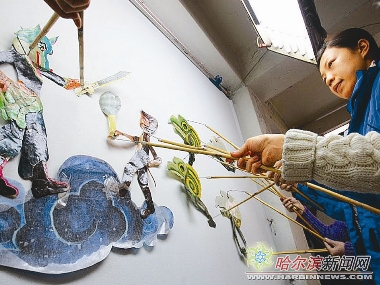
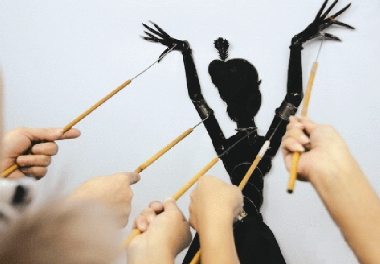
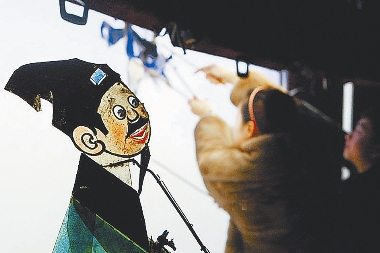
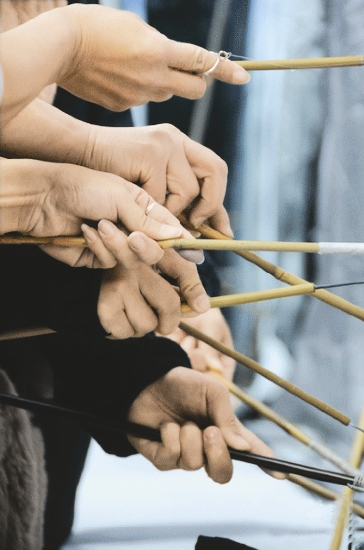
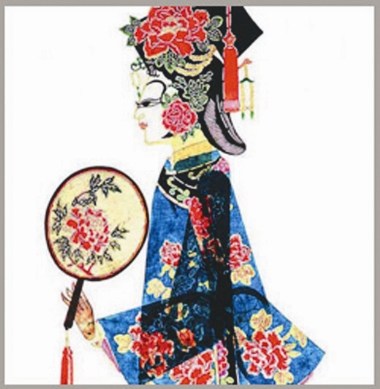
MU YUQIN looks carefree as she watches a leather puppet performing a delicate dance, carefully manipulated by four young puppeteers.
However, times had been tougher for Mu and the shadow play troupe she manages, as a lack of young performers and dwindling audiences have left the art form high and dry since the 1980s.
Shadow plays date back nearly 1,000 years and feature intricately designed leather puppets that are manipulated behind a translucent backdrop, casting the shadows that give the art form its name.
Mu heads a shadow play troupe affiliated with the Harbin Children’s Art Theater in Northeast China’s Heilongjiang Province. Her troupe belongs to the Longjiang shadow play school, which originated during the Qing Dynasty (1644-1911) and utilizes elements from northeastern folk music and operas.
As one of the art form’s three major schools, the Longjiang school differs from its counterparts in terms of how it combines acting and singing. The school blossomed in the 1960s but ran into trouble around the end of the 1980s, when the country’s opening-up policies gave the public access to new choices for entertainment.
The troupe had to lay off its musical accompanists to reduce costs and use recorded music instead, due to decreased income as a result of plummeting attendance. Mu’s troupe decided to cut down on its use of singing in order to woo younger audiences, who are not typically attracted to the old-fashioned lyrics and music often featured in shadow plays.
The changes have allowed Mu’s troupe to hang on a little longer, but also caused the art form to lose some of its essence, she said.
However, Mu is hopeful about the future of her profession, as the government has made more efforts to protect forms of intangible cultural heritage (ICH) over the past decade.
The country published its first national ICH list in 2006 and put its law on ICH protection into effect in June of this year.
The Longjiang shadow play school was listed as a form of provincial intangible cultural heritage in 2007. It was added to the national ICH list in May this year, with Mu’s troupe approved as a “group inheritor” of the traditional art, allowing the group to receive policy and financial support from the government.
The troupe is planning to buy new musical instruments and seek out musicians to accompany their plays, according to Zhao Guozhong, president of the Harbin Children’s Art Theater.
“We’ll try to regain the original essence of Longjiang shadow plays through the guidance of an older generation of artists. Traditions cannot be lost,” said Zhao.
The troupe is in the process of recruiting more local performers and plans to send 12 young performers to schools in Shanghai for professional training, according to Zhao. Performers born in the 1980s and 1990s have become the backbone of the 13-member troupe in recent years.
“We should keep tradition in mind while trying to cater to our audience. This is why we sought to be added to the ICH list. We’ll become ‘sinners of history’ if we do not take measures to protect our traditional art,” said Xue Zhaoping, one of the troupe’s members. (Xinhua)
China mulls setting up special fund to boost arts
CHINA is considering setting up a special fund to finance arts creation and cultural performances in the latest move to develop the country’s soft power, a cultural official said Sunday.
The fund, which is likely to be set up in 2012, will pool an initial investment of 200 million yuan (US$31.54 million) from the government and private investors to support various forms of arts ranging from opera and ballet to Chinese folk opera, said Tao Cheng, vice head of the arts department under the Ministry of Culture.
Tao said from the sidelines of an opera festival held in the eastern city of Fuzhou that the fund will gradually expand to 800 million yuan over the years. He said the ministry has drawn up the draft and it will be deliberated and finalized.
China’s top leadership has recently attached greater importance to improving the country’s cultural soft power after decades of economic growth. In the sixth plenary session of the 17th Central Committee of the Communist Party of China last month, the nation’s decision makers focused on cultural issues. It was the first time in 15 years that the plenary sessions have put the spotlight on culture.
The Ministry of Finance had said it would increase expenditure on museums, cinemas, music companies, publishing houses and other cultural institutions, and ensure that public spending on the sector grows faster than fiscal income growth. Support policies will be targeted, with a focus on improving the cultural institutions’ market competitiveness, it said. (Xinhua)
|

